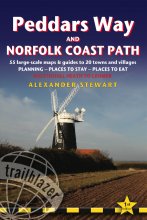Wonderful handbooks
— The Bookseller

Peddars Way and Norfolk Coast Path
Excerpt:
Using this guide
Contents | Introduction | About the Peddars Way & Norfolk Coast Path | Practical information for the walker | Itineraries | Using this guide | Sample route guide: Knettishall Heath to Little Cressingham
Using this guide
The trail guide and accompanying maps have not been divided up
into rigid daily stages since people walk at different speeds and have
different interests. The route summaries below describe the trail
between significant places and are written as if walking north
towards the coast and then east along it since this is by far the most
popular direction for people tackling the trail. To enable you to plan
your own itinerary, practical information is shown clearly on the trail
maps. This includes walking times for both directions, places to stay,
camp and eat, as well as shops where you can stock up on supplies.
Further service details are given in the text under the entry for each
place. For an overview of this information see Itineraries, pp28-30.
TRAIL MAPS [for map key see p189]
Scale and walking times
The trail maps are drawn at a scale of 1:20,000 (1cm = 200m; 31/8
inches = 1 mile). Walking times are given along the side of each map
and the arrow indicates the direction to which that time refers. Black
triangles show the points between which the times have been taken.
See note on walking times, below.
The time-bars are there as a guide and are not to judge your
walking ability. Any number of variables will affect the speed at
which you actually walk, from the weather conditions to the number
of beers you drank the previous evening. After the first few hours’
walking you should be able to gauge how your speed relates to the
timings on the maps.
Up or down?
The trail on the maps is marked as a broken line. An arrow across the
trail indicates an incline: it always points to the higher ground. Two
arrows show that the slope is steep. If, for example, you are walking
from A (at 80m) to B (at 200m) and the trail between the two is short and steep
it would be shown thus: A– – – > > – – –B. If the arrow heads were reversed
they would indicate the trail was downhill.
Latest tweets